#chugoku
Video
Storm above Okayama Castle (Okayama, Japan) por Shanti
Por Flickr:
Okayama-jo, the "Crow Castle" one minute before the storm. ____ Okayamako gaztelua, ekaitza baino minutu bat lehenago. ____ El Castillo de Okayama un minuto antes de la tormenta. ....... ....... ....... ....... ........ ....... Maybe is better on black (press "L" in your keyboard)
#岡山市#Okayama-shi#Okayama#Chugoku#park#japanese#garden#Japan#Japonia#Japón#green#後楽園#Okayama-jo#Castle#castillo#samurai#daimyo#sky#storm#stormy#tormenta#summer#2012#architecture#arquitectura#traditional#tradition#building#historic#clouds
48 notes
·
View notes
Text
My latest for Unseen Japan, on the history of okonomiyaki.
But did you know there is a Tohoku regional version of okonomiyaki, too? It's called Dondonyaki! You can expect an episode about it on my podcast Friday Night History in the not-too-distant future. Previews will be up shortly for patrons at komaneko.gay!
10 notes
·
View notes
Text
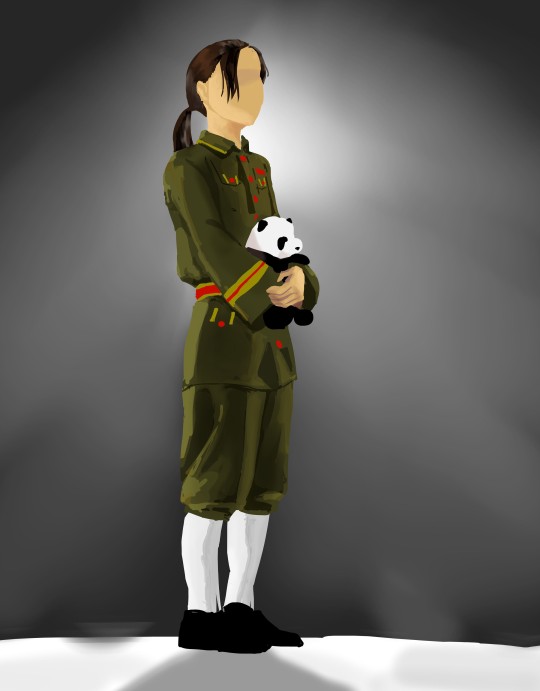
China's stage actor from the Hetalia stage play!
YEAH
I wanted to paint something.
Digitally I mean-
And I could not be bothered making anything up,
So I got reference instead!
And no, I did not feel like doing his face,
Feel free to use your imagination!
Also, fun fact, if you look up Taishi Sugie (China's stage play actor) on Pinterest, it will assume you mean sushi. And yes, I learnt that from experience.
#hetalia#hetalia fanart#china#hetalia stage play#stage play#stage play fanart#taishi sugie#hetalia china#chugoku#yeyeye#im learnin#the secrets#of colour#slowly but surely#:D
5 notes
·
View notes
Text
I'm late, but ~
Happy birthday, China! 生日快樂!!
*boop!*


#hetalia art#hetalia fanart#hetalia#hetalia china#chugoku#wang yao#yao wang#happy birthday#digital drawing#digital art#ibispaintx#ibispaintapp#ibispaint art#hetalia world stars#hetalia axis powers#axis powers ヘタリア#ヘタリア#hetalia world twinkle
13 notes
·
View notes
Photo

Black rain
At the Hiroshima Peace Memorial Museum, Hiroshima, Chugoku.
White wall with streaks of black rain
3.700 m from the hypocenter Furuta-machi, Takasu Donated by Akijiro Yashima
On a house 3,700 meters west of the hypocenter, the blast opened a gap between the roof and the wall. The black rain entered the house through the gap, leaving these black streaks on the white plaster wall. Analysis of the streaks found small amounts of radioactive fallout from the A-bomb explosion.
4 notes
·
View notes
Text
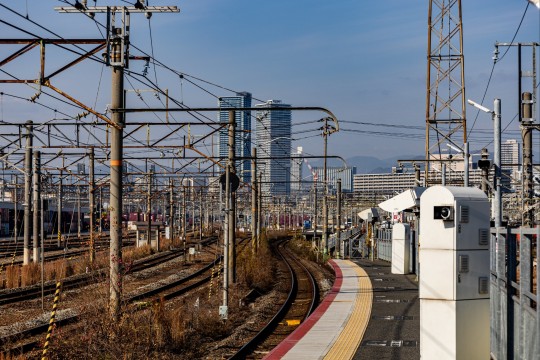
3 notes
·
View notes
Link
Visitare il Museo della Katana di Osafune, prefettura di Okayama #viaggiaescopri #travelwebtv #lelelatta
0 notes
Text
Nagato
La ville de Nagato est située dans la préfecture de Yamaguchi, au Japon. Riche en nature, la région regorge de sites touristiques attrayants.
#japon #voyage #tourisme
#culture #evasion #chugoku #omijima #nagato
La ville de Nagato est située dans la préfecture de Yamaguchi, au Japon. Riche en nature, la région regorge de sites touristiques attrayants. Les villes environnantes sont également célèbres pour leurs sites touristiques et certaines d'entre elles sont considérées comme les sites les plus fascinants du Japon. Toute la côte nord de Nagato comprend le parc quasi-national de Kita-Nagato, une zone…

View On WordPress
1 note
·
View note
Text
not to be a geek but u kno how when u r a fan of a series set in a rl life place, u would have the urge to visit that place like a pilgrimage right. so banana fish is set in nyc but i have never once thought of going lol
#izumo is in my bucket list tho#but according to smth i found on the jp webz#apparently fly boy had eiji being originally from tottori (hence the matsuba crabs)#then it got revised to izumo after bf#not a big deal since they are both in the rural sanin region#but still a cute trivia if true#(forgot where i found it tho so take with grain of salt)#also would wanna visit onomichi frm shimanami tasogare#so could hit 2 birds with 1 stone with a chugoku region travel plan#dont think it'll ever happen but its nice to dream 🤤
4 notes
·
View notes
Text
日本のトリビアまとめ #0011
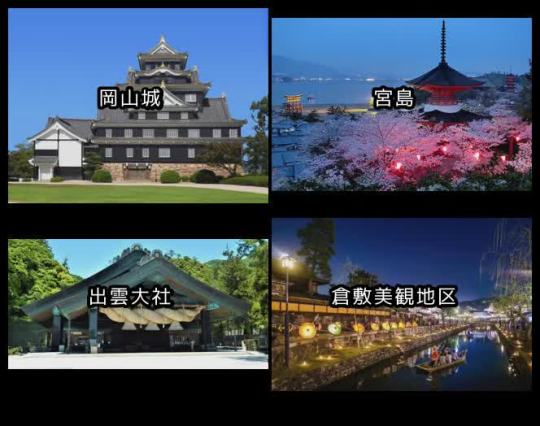
#Japanese Trivia#宮島#Miyajima#出雲大社#Famous places in the Chugoku region#Izumo Taisha Shrine#Kurashiki Bikan Historical Quarter#日本���トリビア#Okayama Castle#中国地方の名所#倉敷美観地区#岡山城
0 notes
Photo
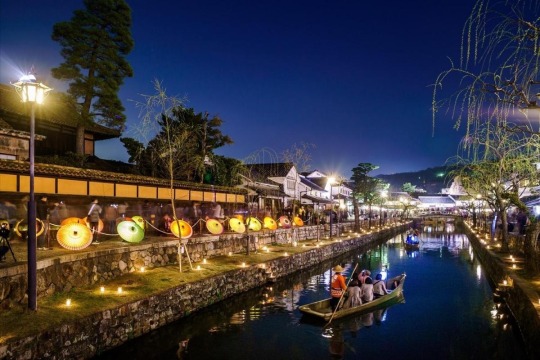
倉敷美観地区
中国地方の名所
倉敷美観地区(くらしきびかんちく)は、岡山県倉敷市に位置する、江戸時代の町並みが現存する歴史的地区で、美しい風情が残る観光地です。
この地区は、倉敷川沿いに広がる町並みで、明治時代に保存活用された歴史的な建造物や白壁の蔵、商家が立ち並ぶ風景が特徴です。古い町並みや細い小道が続き、昔ながらの雰囲気が残る一帯が、多くの観光客に愛されています。
倉敷美観地区には、美術館やギャラリー、カフェ、工芸品のお店なども点在し、伝統工芸品やアートなど様々な文化が楽しめます。また、倉敷美観地区の観光名所として、各家屋の蔵に保存されている歴史資料や説明板も見どころの一つです。
さらに、地区内を運行する倉敷観光周遊船に乗船することで、水辺からの景観を楽しむこともできます。また、季節によってはイベントや催し物も開催され、観光客に楽しい体験を提供しています。
倉敷美観地区は、日本の伝統的な風景や文化を存分に楽しめる場所として、国内外から多くの観光客に愛されています。
♪♫♬🎤🎹🎶♪♫♬🎤🎹🎶♪♫♬🎤🎹🎶♪♫♬🎤🎹🎶
Kurashiki Bikan Historical Quarter
Famous places in the Chugoku region
The Kurashiki Bikan Historical Quarter (Kurashiki Bikanchiku) is a historical district located in Kurashiki City, Okayama Prefecture, where the townscape of the Edo period still exists, and is a tourist destination with a beautiful atmosphere.
This district is a townscape that stretches along the Kurashiki River, and is characterized by historic buildings preserved and utilized during the Meiji period, white-walled storehouses, and merchant houses. The area is loved by many tourists because of its old townscape and narrow alleys, which retain a traditional atmosphere.
The Kurashiki Bikan Historical Quarter is dotted with museums, galleries, cafes, and craft shops, where you can enjoy a variety of culture including traditional crafts and art. Also, as a tourist attraction in the Kurashiki Bikan Historical Quarter, the historical materials and explanatory boards preserved in the storehouses of each house are one of the highlights.
Additionally, you can enjoy the scenery from the waterside by boarding the Kurashiki sightseeing cruise that operates within the area. Events and entertainment are also held depending on the season, providing a fun experience for tourists.
The Kurashiki Bikan Historical Quarter is loved by many tourists from Japan and abroad as a place where you can fully enjoy Japan's traditional scenery and culture.
#倉敷美観地区#中国地方の名所#Kurashiki Bikan Historical Quarter#Famous places in the Chugoku region#日本のトリビア#Japanese Trivia
0 notes
Text
Chronicle 2022
ときに絶望的な無力感に陥るほど、至るところで、また相次いで暴力が剝き出しになった一年でした。その暴力は直接に破壊的なものだけではありません。社会を壊し、そこに生きる者を蝕んだうえに、直接的な暴力の前に晒し出す暴力も、さまざまなかたちで露わになった年だったと感じています。もちろん、この一年を振り返るにあたり、ウクライナで今も続く戦争の暴力を挙げる必要があるのは確かでしょう。2月24日、ロシア軍のウクライナ各地への攻撃が始まったという報せを聞いたときの衝撃は忘れられません。
現在も続いている攻撃によるウクライナの民間人の死者は、記録されているだけでも七千人に達しようとしているとのことです。痛ましい犠牲です。大切な人を失った人々の悲しみを思うと言葉がありません。そして、生き残った人々の苦悩は、今も積み重なるばかりです。生活を根こそぎにされて避難を余儀なくされた人々や、生活の基盤を破壊されて恐…

View On WordPress
#Chugoku Shinbun Newspaper#燃エガラからの思考#Eri Watanabe#Franz Schubert#Hiroshima Happy New Ear#Hiroshima Symphony Orchestra#Impact Press#Mercure des Arts#Nobuyuki Kakigi#The Kyushu Symphony Orchestra#Toru Takemitsu#Toshio Hosokawa#Toshoshimbun Newspaper#Walter Benjamin#柿木伸之
0 notes
Text
no, miss appleton did not single-handedly ruin japanese soy sauce forever
there's a popular post going around this week about a ghq (general headquarters, the administration of the american occupation of japan after wwii) employee, a certain ms. blanche appleton, single-handedly changing the taste of soy sauce. while her story is fascinating for sure and i await further developments on the part of the op, and had a hand in the history of soy sauce, the premise is quite a bit exaggerated, and the general narrative so far in the framing by the op somewhat problematic.
tl;dr: as with most things, this is a confluence of factors, with producers, scientists, politicians, (possibly underworld,) and administrators all having their own agency in this story. i find it unusual to sideline so many parties in favour of presenting a single foreign administrator calling the shots in the op's posts.
i've made an initial response here. i will continue my findings in a separate post here.
1. jack daniel's is swill, but it's still whiskey
i think i can distill my issues with this plot so far down to one statement in the original post:
There should be records of her policies, there should be legal documents in America which record how she apportioned out American exportation of soy beans to Japan, there should be sources talking about this woman's ability to transform Japan's soy sauce production so heavily that today only 1% of all soy sauce is made with pre-WW2 traditional techniques.
this transformative impact of one administrator is entirely overstated. this comment led me to a promo blog post where some of the original claims can be seen, and the op mentions that traditional soy sauce was made in kioke barrels, and the this method of production has dropped to about 1% now. this is true, but it appears that at least one source put the decline as starting around the end of the edo period (xvii-xix centuries). [1] sources traceable to yamaroku puts the decline more recently, at about a century ago [2, 3]
this japanese paper on fermented food production is quite clear in stating that wodden barrel production declined from the meiji period (1868-1912) onward.
江戸時代までに一般化した木桶・木樽の使用形態は、明治期以降、一般の生活や各種製造現場で近代化が進む中、コンクリートや金属、プラスチック、合成樹脂等の材質によって代替されていく。
The use of wooden vats and barrels, which had become common by the Edo period, was replaced by materials such as concrete, metal, plastic, and synthetic resin from the Meiji period onward, as modernization progressed in ordinary life and various manufacturing sites. (deepL translation)
another source from a professor on food production in japan suggests that shodoshima (where yamaroku is made) is the area that has most completely preserved the wooden vat method of production.
this survey (oguri) written by a member of the national museum of nature of science in tokyo dates the supplanting of traditional method in more industrialized regions by 1913
1913(大正2)年:栂野は「最新醤油醸造論」の中で、九州、中国地方では桶の代わりに煉瓦又は石でタンクを作り使用していると記述。
1913 (Taishō 2): Tsugano, in his "The Latest Soy Sauce Brewing Theory," wrote that in Kyushu and Chugoku regions, instead of vats, tanks were made of bricks or stone and used. (deepL translation, p.148)
1918年:西二の蔵(ヤマサ印)の建設に当たり研究中の内面塗料が完成したので、これを採用し仕込桶を角型のコンクリートタンクに改めた。
1918: The internal [coating] that was being researched for the construction of the Nishi Ni no Kura (Yamasa brand) was completed, and this was adopted and the brewing vats were replaced with square concrete tanks. (deepL translation with edits from @literaryreference, see translator's note 3, p.148)
i think it bears repetition that soy sauce production was industrializing as japan was industrializing from the meiji to early shōwa periods. as alluded to in the title, a lot of modern soy sauce is like jack daniels: industrial products that evolved from traditional methods alongside a nation's overall development.
2. babe wake up, a new semichemical soy sauce just dropped, and appleton's role in history (a corroboration of @/inneskeeper)
it seems like the plot on the original poster's part has gone to the american side, so let's try to follow the us-japan interaction but from japanese sources.
the survey cited earlier (oguri) has a lot of information that supports the original post. blanche appleton did exist, and does appear in more anecdotes from that era of the soy sauce industry.
(also, this bibliography has more sources on her time in japan, will require institutional access to japanese universities)
to start, there are two methods of semichemical soy sauce production. the first, 新式1号法 shinshiki 1-gō method (i will call it sc1) was invented in the taishō era (1912-26).
大正の末期頃になると、酸やアルカリの化学薬品を併用することによって、速醸の目的を達成しようとする研究が盛んに行われ、その代表的な「新式1号」が出現する。
Toward the end of the Taisho era, there was a flurry of research into the use of acid and alkali chemicals in combination to achieve the goal of fast brewing, and the "Shinshiki No. 1" [sc1] appeared as a representative example of such research. (deepL translation, p.158)
in the time immediately after the war, there was a shortage of supplies, and its allocation was controlled by the americans
駐留軍の総司令部 GHQ(General Head Quarter)は、1948年の春調味料の原料として「エロア資金」(占領地域経済復興資金)により、大豆ミール2万tを放出する方針を打ち出した。このことにより、その配分をめぐって醤油業界とアミノ酸業界は熾烈な競争をすることとなる。
The General Head Quarter (GHQ) of the stationed army announced a policy of releasing 20,000 tons of soybean meal as a raw material for seasonings in the spring of 1948 through the EROA (Economic Rehabilitation in Occupied Area) Fund. This led to fierce competition between the soy sauce and amino acid industries for its allocation. (deepL translation with edits by myself, p.159)
the "amino acid industry" mentioned refers to the monosodium glutamate (msg) industry (glutamate is the ion of an amino acid). essentially, in the early 20th century, both msg and soy sauce (and chemical "soy sauce") production methods have converged to all requiring many soybeans due to their protein content and fermentation properties.
this is where appleton makes her entrance:
GHQは両業界の調整窓口として、「経済安定本部」の経済科学局で調味料と乳製品の需給を担当していたミセス・ブランシェ・アップルトンをその任にあてた。アップルトンは、醤油醸造協会の茂木啓三郎とアミノ酸業界の大内鋼太郎を招いて意見を聴取し、原料の配分を「醸造醤油2、アミノ酸業界8」とすることを内定し、上司のマーカット局長に報告した。この報告内容は醸造醤油にとっては死活問題であったが、内定の根拠は次のようなものであった。
GHQ assigned Ms. Blanche Appleton, who was in charge of the supply and demand of seasonings and dairy products in the Economic and Science Section of the "Economic Stability Headquarters," (?) to serve as the coordinating contact between the two industries. Appleton invited Keizaburo Mogi of the Soy Sauce Brewers Association and Kotaro Ouchi of the amino acid industry to hear their opinions, and informally decided that the distribution of raw materials would be two for brewing soy sauce and eight for the amino acid industry, and reported this to her boss, Maj. Gen. W. F. Marquat. The content of this report was a matter of life and death for brewers' soy sauce, but the rationale for the informal decision was as follows. [...] (deepL translation with edits by myself p.159)
essentially, appleton originally intended for only 20% of the soybean meal to be handed out for soy sauce due to its relatively inefficient usage of materials compared to msg production. this would've crippled the existing soy sauce producers, and they set out to find solutions to save their industry.
醸造醤油側は、醸造醤油の「日本人の食生活における重要性や醸造醤油そのものの品質の良さ」等を強調したが、GHQはただ「脱脂大豆が有効に活用されるのはどちらか」という尺度だけで判断したのである。このような醸造醤油の存亡の危機を救ったのは、もくもくと研究に携わっていた技術陣が開発した「新式2号法」であった。本法を発明したのはキッコーマンの館野正淳、梅田勇雄等である。新式2号の製法は新式1号と同様に、蛋白質を弱酸でペプトンやペプチド程度まで分解し、その後は麹の酵素により分解してアミノ酸の形態まで持っていく半化学、半醸造による醤油の製造法である。
The brewing soy sauce side emphasized the importance of brewing soy sauce in the Japanese diet and the quality of the soy sauce itself, but GHQ made its decision based solely on the basis of "which [industry] would use the defatted soybeans more effectively". What saved brewed soy sauce from the brink of extinction was the "New Formula No. 2 method" developed by the technical staff who had been working diligently on the research. The inventors of this method were Masajun Tateno and Isao Umeda of Kikkoman Corporation. As with Shin-Shiki No. 1 [sc1], the Shin-Shiki No. 2 [sc2] method is a semi-chemical, semi-brewing method for producing soy sauce in which proteins are broken down to peptones and peptides with weak acids, and then decomposed by enzymes from koji mold to the form of amino acids. (deepL translation with edits by myself and @literaryreference, see translator's note 4, p.159)
this development, the invention of the 新式2号法 shinshiki 2-gō method (sc2), led to another round of discussions:
ミセス・アップルトンは「キッコーマンが画期的な技術を開発した」ことを聞き、新法による醤油とアミノ酸液による化学醤油を消費者に提示し、その調査結果に基づいて決定を再考しようと上申書を提出した。醤油の 味、使用テストは神奈川県の鎌倉市と逗子で行われたが、消費者の8割が新法による醤油を支持した。この結果に基づき、アップルトンは両業界で話し合って結論を出すように「正田・大内会談」を開かせた。
Mrs. Appleton heard that "Kikkoman had developed a breakthrough technology" and submitted a petition to reconsider her decision based on the results of a survey that presented consumers with both the new method of soy sauce and a chemical soy sauce made with amino acid solution. Taste and use tests of soy sauce were conducted in Kamakura and Zushi, Kanagawa Prefecture, and 80% of consumers supported the new soy sauce. Based on these results, Appleton had the "Shoda-Ouchi Conference" held so that the two industries could discuss and reach a conclusion. (deepL translation, p.160)
this source seems to suggest that the original decision was under higher-ups' pressure:
当初の提案2対8のアミノ酸業界絶対優位の配分比率は、「新式2号法」の出現により、最終的にGHQは「正田・大内会談」の「7対3協定」を認め、ここに醸造醤油の歴史的危機は回避されることとなった。醤油業界のミセス・アップルトンの評価は従来大変厳しいものであったが、後の調査で彼女は醸造醤油の良き理解者であり、当初の配分比率も上司の強い指示に抗しきれず提案したものであったようである。再度の上申は、彼女の日本の伝統的な醸造醤油への深い理解と思い入れによるものであったと考えられる。
As for the proposed allocation of 2 to 8, due to the [sc2] method, GHQ ended up deciding on the “7 to 3 Agreement” from the “Shoda-Ouchi Conference” instead, thus averting the historical crisis of brewed soy sauce.Although the soy sauce industry had been very critical of Mrs. Appleton in the past, later investigations revealed that she was a firm supporter* of brewed soy sauce and that the original allocation ratio was a proposal she made because she could not resist the strong instructions of her superiors. It is believed that her renewed offer was due to her deep understanding of and commitment to the Japanese tradition of brewed soy sauce. (deepL translation with edits from myself and @blackamite, see translators' note 1, p. 160)
the term 良き理解者 "good friend" (see bolded) i think could mean connoisseur or enjoyer here, will need help in clarifying.
その後醤油醸造協会の正田会長は、1948(昭和23)年7月23日に「新式2号法」の特許公開を懇請し、当時の中野社長の決断により、「新式1号」に続いて「新式2号」についても無償で業界に公開されることとなった。同年8月から講習会が全国12ブロックで開催され、約2,500社の業者が技術を習得した。
Later, on July 23, 1948, Mr. Shoda, president of the Soy Sauce Brewers Association, requested that the patent for the [sc2 method] be made public, and following the decision of then [Kikkoman Inc.] President Nakano, the [sc1 and sc2 methods] were made public free of charge to the industry. In August of the same year, training sessions were held in 12 blocks throughout Japan, and approximately 2,500 companies learned the technology. (deepL translation with edits by myself, p.160)
the main sources the survey used are a manuscript, 醤油醸造技術の近代化 by 永瀬一郎 Ichirō Nagase, kikkoman inc.'s own historical record (キッコーマン株式会社八十年史; a shorter version can be found here), and a history of choshi shoyu inc. (銚子醤油株式会社 社史). i think this confirms a lot of information the original post put out there about ms. appleton and her involvement with soy sauce. plus, it shed more light into how exactly she interacted with the condiment industries.
perhaps @/inneskeeper will find some shady dealings in their research; when you mix a foreign military force, the collapse of existing institutions, and social upheaval, you're likely to find corruption. ill keep my eyes peeled for that development.
3. no, kikkoman is not "fake" soy sauce, but you might be able to find some echoes of the past
so what happened to semichemical soy sauce now? the survey document does not track its usage after its invention and at the surface level, it seems that the original claim was right, the semichemical method has persisted since the american occupation and we're all just drinking sussy sauce.
in fact, this seemed so obvious that this rumour circulated in japan and was debunked by aficionados two years ago.
the link to kikkoman's own record earlier states that sc2 sauce was discontinued in 1970, and the japanese blog post above repeats that, adding that it has reverted back to honjōzō (本醸造) sauce. this paper in the journal of the brewing society of japan (日本醸造協会誌) has this to say about what became of sc2 sauce:
また,キッコーマンの新式 2号しょうゆ製造法の特許が公開されたのも 1948年で, しょうゆ業界は混合醸造しょうゆおよび混合しょうゆを製造することにより効率よく旨味の強いしょうゆを安価に製造し, しょうゆ原料不足の時代を乗り切ったと考えている 。現在,大手メーカーでは食の安全性や本物志向から混合醸造しょうゆおよび混合しょうゆの製造をやめ本醸造しょうゆだけを製造している 。一方,全国の中小しょうゆメーカーでは,製造設備を全て本醸造しょうゆに切 り換える資金力に乏しく.一旦,消費者に定着した混合しょうゆのニーズにより本醗造しょうゆに切り換えることが出来ず,現在も混合しょうゆが主力商品となっているのではないかと考えている 。
The patent for Kikkoman's new [sc2] soy sauce manufacturing method was also published in 1948, which allowed the soy sauce industry to overcome the shortage of raw materials for soy sauce by producing mixed brewed soy sauce and mixed soy sauces efficiently and inexpensively. Currently, major soy sauce manufacturers have stopped producing mixed brewed soy sauce and mixed soy sauce, and are producing only honjozo soy sauce, due to food safety and the desire for authenticity. On the other hand, small and medium-sized soy sauce manufacturers nationwide do not have the financial resources to convert all of their production facilities to honjozo soy sauce. Once a demand for mixed soy sauce has taken root among consumers, they are unable to switch over to honjōzō soy sauce, and even now, it's possible mixed [kongō or kongō-jōzō] soy sauce might be the top [soy sauce] product. (deepL translation with edits from myself and @literaryreference, see translator's note 2, p.78)
the three types of japanese soy sauce production methods available today are honjōzō (本醸造, fully fermented), kongō-jōzō (混合醸造, mixed fermented with amino acid added prior to fermentation, closest to sc2 method), and kongō (混合, one of the previous two types with additives). [wiki, academic source] these production methods are in parallel to the traditional varieties of sauce, which rather describe the mash and added taste; these elements of the production, rather than the fermentation process, are usually what define the lineage of the sauce in both japan and other soy sauce-producing cultures.
instead of supplanting "genuine" fermented soy sauce, the industrial descendants of sc2 sauce have become their own type of sauce and have carved their own niches in the consumer market. as someone who is not from japan, i would be careful about making any judgment on whether it is "authentic".
4. clarifications
there were a few statements by the original poster that i think need further context for a more accurate understanding. any bolding and italics are mine.
During World War 2 there was a push to industrialize the Japanese soy sauce industry to be better for mass-production. This innovated the chemical fermentation technique and the semichemical fermentation technique utilized by Kikkoman; rather than ferment for four years in gigantic cedar barrels, kioke, instead fermentation takes place for six months or a year in stainless steel barrels which utilize electrolysis to artificially speed up fermentation processes.
the first part is correct, but the word "rather" introduces a false dichotomy; soy sauce production is very diverse and progresses at different paces in different regions (see part 1 of this post). the sauce op has is simply one from a region that has kept their manufacturing method unchanged.
"four years" is arbitrary: different producers have different fermentation periods.
the last part of the statement is not universally true of industrial production; ac current may be used in brewing.
A single American woman named "Ms Appleton" was given total control of apportioning all American soy bean rations to companies, how much, and to who. She had no knowledge of soy sauce, allegedly.
we can lay that last part to rest. it appears that she does. i will also have to mention that "soy sauce" has been imported from china to the usa since the 30s.
She apparently had so much power over Japanese soy sauce production that she could singlehandedly shape its future by threatening to not give soy beans to any company, family, or factory which did not utilize her specific requirements of semichemical fermentation (reduced from chemical fermentation, since it was that abhorrent). These days, the term soy sauce is distinct from traditional shoyu, and requires distinguishment because of such a radical difference the two products are.
is girlboss applesauce really that powerful on her own? this statement was not wrong, but she did have the military that just nuked japan behind her.
did appleton specify one method over others? probably, but i think the dependency went the other way: the invention of sc2 sauce was the only way the industry could be efficient enough for ghq standards.
that last part is just straight up wrong dawg what the hell
i was nicer in my first reply but im not feeling it today
[...] Because there should be way more information on her if this was the case; she was apparently powerful and influential enough during the occupation that she could singlehandedly enforce whatever arbitrary rules she wanted on the soy sauce industry and they had to comply or else have no product at all. That level of power is fucking insane. Imagine having so much raw influence over Japan that you could order them to completely renovate and change how they produce and make SOY SAUCE, literally one of if not THE most important thing in Japanese culinary history--[...]
holy exaggeration batman, this is almost insulting. as with most things, this is a confluence of factors, with producers, scientists, politicians, (possibly underworld,) and administrators all having their own agency in this story. it is incredibly unusual to sideline so many parties in favour of a single foreign administrator calling the shots.
5. what now?
i think there's much to be found out about appleton's dealings, and it would be an interesting story if there did end up being underworld dealings in those negotiations coming to light. i think it is a fascinating slice into that era and how society and institutions interacted in such a fraught situation. overall, i encourage @/inneskeeper's historian work.
that said, it is very important for people to not put a narrative ahead of the facts. i think it is human nature to be attracted to stories that have a clear causality and linearity, but it is something we need to be very careful about when communicating history to a large audience. to anyone who would like to present their findings, consider what your framing of events imply about the state of the time and place you research, and if you are doing all parties justice.
and for the love of god, cite your sources.
if there are any translation issues, please reach out to me and i will edit accordingly and post errata.
erratum 1: jack daniel's is tennesee whiskey, not bourbon, thanks @drdementogrl.
translators' note 1: 良き理解者 could also be translated more literally to “good understander,” thank you @blackamite, @monstrousgourmandizingcats, @leatherbookmark, and others who have given similar notes.
erratum 2 and translator's note 2: @literaryreference has indicated that 一旦,消費者に定着した混合しょうゆのニーズにより本醗造しょうゆに切り換えることが出来ず,現在も混合しょうゆが主力商品となっているのではないかと考えている 。 is more equivocal and did not state an outright larger popularity for kongō/kongō-jōzō type brewing, so it's possible it might be the top product. they also suggested removing redundancies and pointed out a copying mistake from the original source (left out a bit of the japanese text).
translator's note 3: @literaryreference let me know that 塗料 would more accurately be interpreted as "coating" and also gave me a link of the sauce brand mentioned.
translator's note 4: @literaryreference has provided a better translation for GHQはただ「脱脂大豆が有効に活用されるのはどちらか」という尺度だけで判断したのである, and i have made edits from their translation as well for better context.
4K notes
·
View notes
Text
Katekyo Hitman Reborn!: Namimori Location
(Documenting my research process so I won't forget and get confused why I did something in a fic during a later read through. Nothing serious really.)
Where exactly is Namimori in canon?
As I was writing a khr fic, I realized I needed the exact location of Namimori for one sentence. A sentence that wasn't even important in the long run. Rather than abandon that single sentence I decided to try and locate where the town of Namimori would be in Japan. Because apparently I like pain.
There is virtually no information on the actual location of Namimori anywhere. So I had went on a research binge. And I found something that gave me a starting point.
In 2009, there was a special KHR episode that was aired during the Jump Super Anime Tour titled, Vongola Style School Trip, Arrives!
Saying that I found it is not that accurate. Its more that I went looking for an episode like this specifically. This isn't the first time I tried to locate fictional locations on a map for the sake of the plot. And I've realized that episodes centered around trips provide amazing clues, especially where the trip starts, where it ends, the scenery outside etc.
Thats what I hoped for here as well. And the hunch paid off! Between timestamps 3:07-3:10, there's a map. Not very detailed mind you. Just enough to show the direction where they came from. But that's better than nothing.
So they're going to Nagoya city, which is in the Aichi Prefecture. Its in the Chūbu region. It also looks like they're coming from the Kanto region, possibly from the direction of Tokyo.
So that means we can leave out the Kansai, Chugoku, Shikoku, and Kyushu regions in the south. There's no way Namimori is in Hokkaido, or Okinawa, so those two prefectures are out as well. The most likely locations for the town to be in is in the Kanto, and Chubu regions.
Comparing the physical map of Japan with the short glimpse we get, I'm reasonably sure they passed by Mt. Fuji as well.

See that little protrusion under Fuji-san? I'm pretty sure thats what we see in the map shown in the episode. So yeah they passed Mount Fuji.
Another thing, see that arch like thing before the protrusion? Thats Kanagawa prefecture, and we can see in the very beginning of the video, around the 0.03-0.04 timestamps, that they don't start anywhere there.

See? They pass by it completely and started somewhere well before Kanagawa. So Kanagawa is out.
Lets go back to Fuji-san again.
The mountain lies between the Yamanashi and Shizuoka prefecture borders.
That gives us three possible routes:
Chiba-> Tokyo-> Yamanashi-> Shizuoka-> Aichi [Nagoya City}
Tokyo-> Yamanashi-> Shizuoka-> Aichi [Nagoya City}
Yamanashi -> Shizuoka -> Aichi [Nagoya City]
Why did I decide on Tokyo as the starting point in Kanto despite there being other prefectures in the region?
In KHR's seventh volume, Hot Summer Arrives!, we get chapter 57, Swimming at the Sea. Its a beach chapter.
The beach is described as being close by and the fact that Ryohei's boxing club senpai, Kuroda Eiji and his buddies Kisanuki Yukio and Ookura Takuya, apparently work there as lifeguards, supports this. (You know...cos they're in middle school and all and jobs at that age tend to be close by...for civilians at least.)
Which means that prefectures like Saitama, Tochigi, and Gunma, which are all landlocked as you can see on the map below, are automatically disqualified as locations for Namimori.
By that same logic, Yamanashi is also disqualified.
Ibaraki is not counted because despite the abrupt beginning and ending of the map scene in the episode, we can guess that the starting point of the trip wasn't quite that far back. By the curve of the arrow I mean. {Yeah I know this is a reach but I'm pretty sure I'm right.}
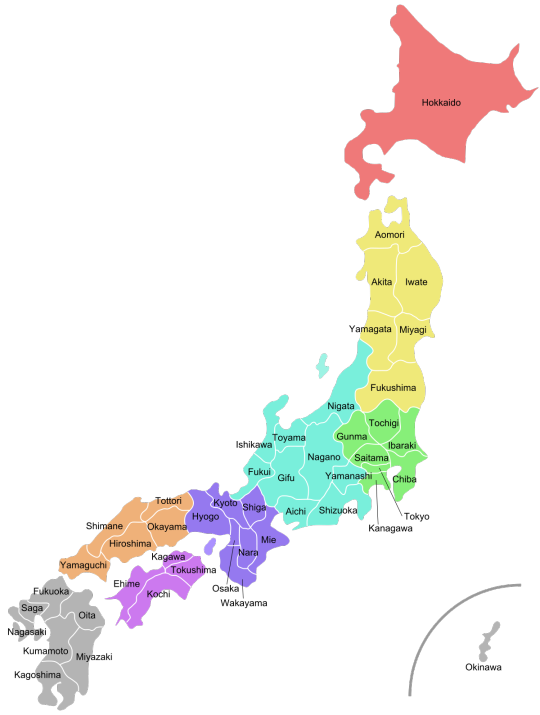
That just leaves Tokyo and Chiba.
The argument in favour of Chiba is a meta one. Tokyo is an iconic location when it comes to manga and anime. Most anime set in Tokyo shows several shenanigans centered around Tokyo's various landmarks. Even works not set in Tokyo sometimes have Tokyo episodes and Tokyo adventures. Like Haikyuu for example.
Considering how much shenaniganry and crackishness KHR has, it would be very strange if it was set in Tokyo and yet didn't have any Tokyo misadventures in it. Reborn would just go ahead and name Tokyo Tower Vongola Tower or something just like he named Nagoya Castle Vongola Castle. So Namimori might not be in Tokyo, but in Chiba instead...which is still part of the Greater Tokyo Area now that I think about it, so still Tokyo in a way?
I couldn't find a way to clearly articulate an argument in favour of Tokyo when a friend send me this link.
I was walking on a path well-tread! @ladydraculena had already slashed through the figurative jungles for me!
I went looking for the two locations marked in the map in their post but it seems like Namimori Steamed Buns has since closed down. Hibari Nursery School on the other hand is going strong.
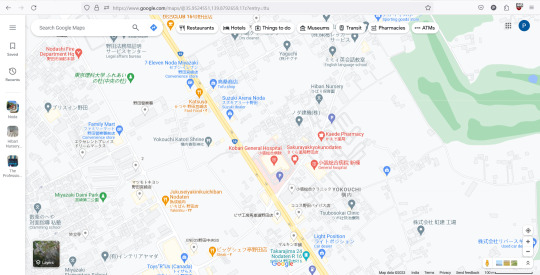
With this information the argument in favour of Tokyo grew much stronger.
Thus canonically the town of Namimori is most likely located in Tokyo and if not in Tokyo proper, definitely in the Greater Tokyo Area.
(Please note that I left the Tohoku region out of this. The region is very distinct and neither anime nor the manga has shown a singular sign of being set in Tohoku. By that I mean that if a work is set in Tohoku, it would be impossible to hide its Tohoku, or mistake it as somewhere else.)
Edit: @rooigseix pointed out that since most of KHR's usual shenanigans strictly happens in Namimori, the usual Tokyo adventure trope meta might not be applicable in this case. Namimori might be far away from Tokyo centre like the Ota or Edogawa districts, which are close to the sea as well.
Edit: @lightning-will-bovino pointed out Kokuyo land and there is in fact a theme park called Noah Forest Amusement Park or Mori-no-Yeunchi near the Hibari Nursery School!
It seems very likely that Amano-sensei was inspired by the area. It might not be where Namimori is actually located but the existence of these establishments in close quarters lends further credence to the theory of Namimori being in the Tokyo area.
In conlusion, the most likely location of Namimori would be in Tokyo prefecture but close to the Chiba border. Not landlocked as well.

Thus, Edogawa ward is the most suitable location.
And after all of that, I decided that Tokyo wasn't a good fit for my fic's Namimori and by my magical writer powers shifted it to Mie Prefecture instead. ╥﹏╥
#Katekyo Hitman Reborn!#KHR#Khr meta#Namimori#Namimori location theory#Hibari Nursery cracked me up tbh#But a bit sad about the Namimori Steamed Buns#Hope they just relocated#Vongola
227 notes
·
View notes
Note
I was replaying the national domination and noticed that Hina and Emma dialogues near the shrine in Shimane (Chugoku region) looks like they're on a date they're so cute ❤️
Oh yeah it does!!! Aww that is cute, love seeing the two of them together


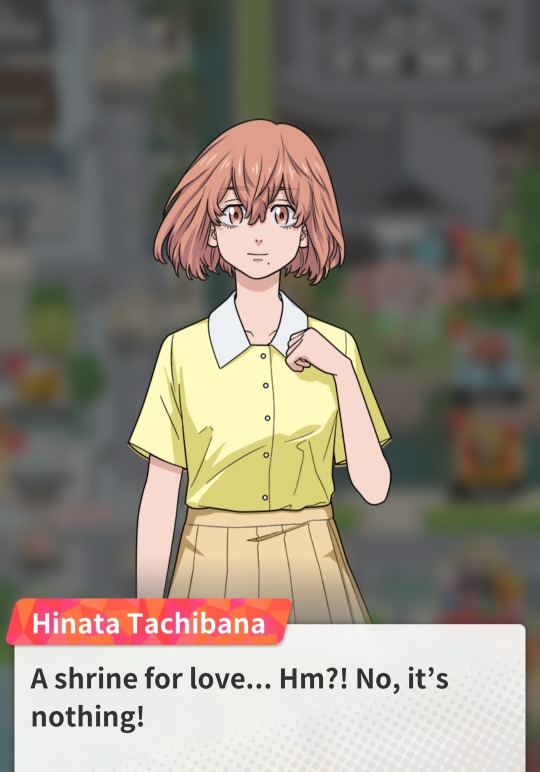
61 notes
·
View notes
Photo

A Prayer for Peace
At the Hiroshima Peace Memorial Park, Hiroshima, Chugoku.
The figures of a mother and a child, 1.4 meters high, are placed on top of a 1.8-meter-high pedestal. The figures were made and offered by Katsuzo Entsuba and the pedestal was built with money sent by students from all over Japan and by the Hiroshima Chamber of Commerce. A child held by his mother is playing the trumpet, with a crescent moon in the foreground. The unveiling ceremony took place on August 2, 1977. At the ceremony, the sculptor Katsuzo Entsuba described the meaning of his creation. "From parent to child, not yesterday but tomorrow, the crescent moon will become a full moon. I want to sound the trumpet for peace in the search for a new future." Beside this statue, there stands a monument where the poem "Dedicated to the Statue of a Prayer for Peace (August, 1978)" by the poet, Shinpei Kusano is engraved.
2 notes
·
View notes